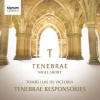Texte paru dans: / Appeared in:

Fanfare Magazine: 37:4 (03-04/2014)
Pour
s'abonner / Subscription information
Les abonnés à Fanfare Magazine ont accès aux archives du
magazine sur internet.
Subscribers to Fanfare Magazine have access to the archives of the magazine
on the net.
Two publications are counted as the masterpieces of Tomás Luis de Victoria (1548–1611), the youngest of the three high Renaissance masters and the only one who focused his output entirely on liturgical music. This ensemble recorded the Officium Defunctorum of 1603 recently (Fanfare 35:2), and now they give us the 18 responsories for Tenebrae, the most admired and frequently recorded part of a large collection of music for Holy Week, the Officium Hebdomadae Sanctae of 1585. The complete Office has been recorded virtually complete several times, and we have heard a long list of recordings of the responsories since 1955. Harry Christophers previously recorded them for Virgin (15:6), following on Peter Phillips (14:5) and David Hill (13:1). Another version by Bruno Turner with Pro Cantione Antiqua (14:1) had been issued on CD from an earlier recording, and another five versions had been heard on LP. Only the second version issued was George Malcolm’s with the Westminster Cathedral Choir, his swansong after 12 years there—a recording on which memory has conferred an aura of greatness that hardly holds up against the reality of comparisons with later versions, especially that of the same choir under David Hill (also his swansong after five years). Bruno Turner, writing the notes for Hill’s recording, thought the composer would “be proud that his own contribution [to the liturgy] could still move hearts and stimulate minds four centuries later” when Tenebrae had been “largely abandoned in the debasement of liturgy by a de-spiritualised Church.”
There are 18 responsory settings for the second and third nocturns of each morning of Holy Week (Thursday to Saturday), for the elaborate lamentations of the first nocturn were followed by a simple chant setting, while the polyphony of these responsories contrasted nicely with the simple lesson tone that preceded each one. We seem to have had no new set of responsories since The Sixteen’s recording over 20 years ago, although the complete Office as well as the set of nine Lamentations have both been recorded more than once. It could be that four versions of varying levels of excellence (none less than good) have served the market very well. The most recent recording of the Lamentations was limited to the three for Saturday added to Gesualdo’s responsories for that day, but Nigel Short’s recording has not arrived for review.
This is a thoroughly beguiling performance at first hearing, for Tenebrae is a good cross between vocal ensemble and choir. But a closer examination shows many fussy expressions in place of the chaste unfolding of the polyphonic lines. The first and third responsories of each nocturn are scored SATB, the second SSAT. Westminster Cathedral Choir under both Malcolm and Hill sang two of the latter responsories down an octave, TTBB. Tenebrae follows this custom only for Tenebrae factae sunt, not for Aestimatus sum ego. All in all, this is a creditable new version. It is hard not to see David Hill, still in the catalog in its original release, and (in the original vocal scoring) Harry Christophers, recently reissued on Virgin Classics Premium, as the preferred choices.
Cliquez l'un ou l'autre
bouton pour découvrir bien d'autres critiques de CD
Click either button for many other reviews



